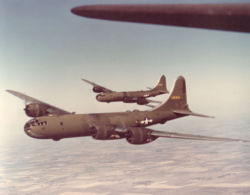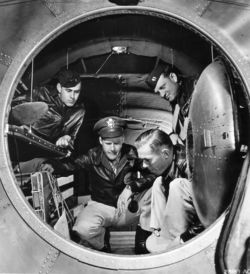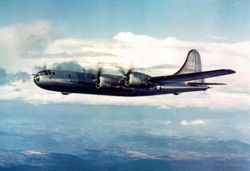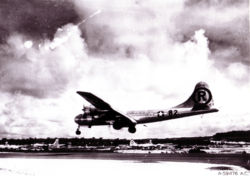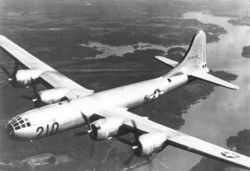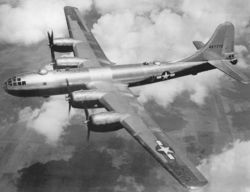PlaneSpottingWorld welcomes all new members! Please gives your ideas at the Terminal.
B-29 Superfortress
| B-29 Superfortress | |
|---|---|
| U.S. Army Air Forces B-29 Superfortress | |
| Type | Strategic bomber |
| Manufacturer | Boeing |
| Maiden flight | September 21, 1942 |
| Primary users | United States Army Air Forces Soviet Air Force (Tu-4, reverse-engineered B-29) |
| Produced | 1943 – 1945 |
| Number built | 3,900 |
| Unit cost | US$639,188[1] |
| Variants | B-50 Superfortress |
The Boeing B-29 Superfortress was a four-engine heavy bomber propeller aircraft flown by the United States Army Air Forces in World War II and other military organizations afterwards. The name "Superfortress" was derived from its well-known predecessor, the B-17 Flying Fortress.
The B-29 (Boeing 341/345) was one of the largest aircraft to see service during World War II. It was one of the most advanced bombers of its time, featuring innovations such as a pressurized cabin, a central fire-control system, and remote-controlled machine gun turrets. It was designed as a high-altitude daytime bomber, but flew more low-altitude nighttime incendiary bombing missions. It was the primary aircraft in the U.S. firebombing campaign against Japan in the final months of World War II, and B-29s carried the atomic bombs that destroyed Hiroshima and Nagasaki. Unlike many other bombers, the B-29 remained in service long after the war ended, a few being employed as flying television transmitters for Stratovision. By the time it was retired in the 1960s, some 3,900 planes had been built.
Contents
Manufacturing and development
Manufacturing the B-29 was a complex task. It involved four main factories: two Boeing plants at Renton, Washington and Wichita, Kansas, a Bell plant at Marietta, Georgia ("Bell-Atlanta"), and a Martin plant at Omaha, Nebraska ("Martin-Omaha"). Thousands of subcontractors were involved in the project. Because of its highly advanced design, challenging requirements, and immense pressure for production, development was deeply troubled. The first prototype crashed during testing, killing the entire crew and several ground personnel. Changes to the production craft came so often and so fast that in early 1944, B-29s would leave the production lines and fly directly to modification depots for extensive rebuilds to incorporate the latest changes. This 'Battle of Kansas' (a trouble-shooting modification program to get four groups ready for combat by January 1, 1944) nearly sank the program, which was only saved by General Hap Arnold’s direct intervention. It would still be nearly a year before the aircraft was operated with any sort of reliability.
The most common cause of maintenance headaches and catastrophic failures was the engine. Though the Wright R-3350 would later become a trustworthy workhorse in large piston-engined aircraft, early models were beset with dangerous reliability problems, many caused by demands that the B-29 be put in operation as soon as possible. It had an impressive power-to-weight ratio, but this came at a heavy cost to durability. Worse, the cowling Boeing designed for the engine was too close (out of a desire for improved aerodynamics), and the early cowl flaps caused problematic flutter and vibration when open in most of the flight envelope. The 18 radial cylinders, compactly arranged in front and rear rows, overheated because of insufficient flow of cooling air, which in turn caused exhaust valves to unseat.
These weaknesses combined to make an engine that would overheat regularly at combat weights, particularly during climbs after takeoff. Unseated valves released fuel-air mixtures during engine combustion that acted as a blowtorch against the valve stems. When these burned through the engines disintegrated and caught fire. A fire that was not immediately contained in the forward part of the engine by fire extinguishers became impossible to put out. An accessory housing manufactured of magnesium alloy in the back of the engine would often catch fire and produce heat so intense it burned through the firewall to the main wing spar in no more than 90 seconds, resulting in catastrophic failure of the wing.
This problem would not be fully cured until the aircraft was re-engined with the more powerful Pratt & Whitney R-4360 'Wasp Major' in the B-29D/B-50 program, which arrived too late for World War II. Interim measures included cuffs placed on propeller blades to divert a greater flow of cooling air into the intakes, which had baffles installed to direct a stream of air onto the exhaust valves. Oil flow to the valves was also increased, asbestos baffles installed around rubber push rod fittings to prevent oil loss, thorough pre-flight inspections made to detect unseated valves, and frequent replacement of the uppermost 5 cylinders (every 25 hours of engine time) and engines (75 hours).
Pilots, including the present-day pilots of the Commemorative Air Force’s Fifi, describe flight after takeoff as being an urgent struggle for airspeed; generally, flight after takeoff should consist of striving for altitude. Radial engines need that airflow to keep cool, and failure to get up to speed as soon as possible could result in an engine failure and risk of fire. One helpful technique was doing a rolling start, rather than a braked start, and checking the magnetoes while already in motion.
In wartime, the B-29 was capable of flight up to 40,000 feet, at speeds of up to 350 mph (true airspeed). This was its best defense, for fighters of that day could barely get that high, and few could catch it, even if they were already up there and waiting. Only the heaviest of anti-aircraft weapons could reach it. The crew enjoyed, for the first time in a bomber, full pressurized comfort. The nose and the cockpit were pressurized, but the designers were faced with deciding whether to have bomb bays that were not pressurized, between fore and aft pressurized sections, or a fully pressurized fuselage with the need to de-pressurize to drop their loads. The decision was taken to have a long tunnel over the two bomb bays so that crews could crawl back and forth between the fore and aft sections, with both areas and the tunnel pressurized.
Operational history
World War II
The initial plan, implemented at the direction of President Roosevelt as a promise to China and called Operation Matterhorn, was to use B-29s to attack Japan from four forward bases in southern China, with five main bases in India, and to attack other targets in the region from China and India as needed. The Chengdu region was eventually chosen over the Guilin region to avoid having to raise, equip, and train fifty Chinese divisions to protect the advanced bases from Japanese ground attack. The XX Bomber Command, initially intended to be two combat wings of four groups each, was reduced to a single wing of four groups because of the lack of availability of aircraft, automatically limiting the effectiveness of any attacks from China.
This was an extremely costly scheme, as there was no overland connection available between India and China, and all the supplies had to be flown over the Himalayas. B-29s started to arrive in India in early April 1944. The first B-29 flight to airfields in China (over the Himalayas, or "The Hump") took place on 24 April 1944. The first B-29 combat mission was flown on 5 June 1944, with 77 out of 98 planes launched from India bombing the railroad shops in Bangkok (Five B-29s were lost to non-combat causes).
On 15 June 1944, 47 B-29s launched from Chengdu in China bombed the Imperial Iron and Steel Works at Yawata, Japan. This was the first attack on Japanese islands since the Doolittle raid in April 1942. The first B-29 combat loss occurred during this raid, with one B-29 destroyed on the ground by Japanese fighters after an emergency landing. Because of the extreme cost of operations, the raids against Japan from Chinese airfields continued at relatively low intensity. Japan was bombed on: 7 July 1944 (14 B-29s), 29 July (70+), 10 August (24), 20 August (61), 8 September (90), 26 September (83), 25 October (59), 12 November (29), 21 November (61), 19 December (36) and for the last time on 6 January 1945 (49). B-29s were withdrawn from airfields in China by the end of January 1945. Throughout this period B-29 raids were also launched from China and India against many other targets throughout Southeast Asia. However, the entire B-29 effort was gradually shifted to the new bases in the Marianas, with the last B-29 combat mission from India flown on 29 March 1945.
The need to use inconvenient bases in China for attacks against Japan ceased after the capture of the Marianas islands in 1944. On the islands of Tinian, Saipan and Guam five major airfields, each constructed as a base for a four-group wing of B-29s, became the launch sites for the large B-29 raids against Japan in the final year of the war. The islands could be easily supplied by ship. The first B-29 arrived on Saipan on 12 October 1944, and the first combat mission was launched from there on 28 October 1944, with 14 B-29s attacking the Truk atoll. The first mission against Japan from bases in the Marianas was flown on 24 November 1944, with 111 B-29s sent to attack Tokyo. From that point ever more intense raids were launched regularly until the end of the war. These attacks succeeded in devastating all large Japanese cities and gravely damaged Japan's war industries. Although less appreciated, the aerial mining program carried out by B-29s against Japanese shipping routes and harbor approaches had profoundly degraded Japan's ability to support its population and fight the war.
Perhaps the most recognized B-29 is the Enola Gay, which dropped the atomic bomb 'Little Boy' on Hiroshima on 6 August 1945. Bockscar, another B-29, dropped 'Fat Man' on Nagasaki three days later. Both aircraft were handpicked for modification from the assembly line at the Omaha plant that was to become Offutt Air Force Base.
The B-29 was used in World War II only in the Pacific Theatre.
Korean Conflict and Postwar Service
The B-29 was later used in the Korean War. At first, the bomber was used in normal strategic daylight bombing missions, though North Korea's few strategic targets and industries were quickly reduced to rubble. More importantly, in 1950 numbers of Soviet MiG-15 'Fagot' jet fighters appeared over Korea (a plane specifically designed to shoot down the B-29), and after the loss of several aircraft, future B-29 raids were restricted to night-only missions, largely in an interdictive role. Over the course of the war, B-29s flew 20,000 sorties and dropped 200,000 tons (180,000 tonnes) of bombs. B-29 gunners were credited with shooting down 27 enemy aircraft.[2]
The B-29 was soon made obsolete by the development of the jet engine. With the arrival of the mammoth Convair B-36, the B-29 was reclassified as a medium bomber with the new Air Force. However, the later B-50 variant (which was temporarily designated "B-29D") was good enough to handle auxiliary roles such as air-sea rescue, electronic intelligence gathering, and even air-to-air refueling. The B-50D was replaced in its primary role during the early 1950s by the Boeing B-47 Stratojet, which in turn was replaced by the Boeing B-52 Stratofortress. The final active duty variants were phased out in the mid 1960s. 3,970 B-29s were built before they were retired in 1960.
Flying characteristics
In flight, the pilot called for engine and flap settings, much like a ship captain would call for "left rudder" or "full speed ahead," instead of moving the throttles and the flap levers himself. Another innovation was the number of calculations the crew had to perform before and during the mission. Prior to the B-29, flight manuals provided only approximate performance figures and pilots relied largely on instincts and experience. The B-29 manual had charts to compute takeoff and landing speeds based on weight, elevation, and temperature. Finding the optimum power settings for cruise required consideration of cruise altitude, outside temperature, aircraft weight, and desired true airspeed. The power settings were recalculated every two hours or with every change in altitude. These types of computations are routine in modern civil and military aviation but were a groundbreaking innovation in 1944. The benefits of improved range and performance were irrefutable.
Most pilots found the B-29 relatively mild-mannered, though its unboosted controls were extremely heavy and required considerable physical strength to operate (Higham 1975). Though it could be flown with only two engines once airborne, the plane suffered from engine overheating issues throughout its service and at full gross weight several B-29s crashed in Saipan after a single engine failure on takeoff. The expansive glazed nose and forward seating position left pilots without a point of reference, forcing many to fly on instruments at all times.
Variants and design stages
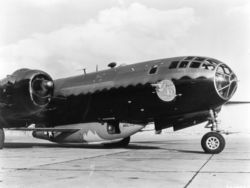
Unlike many other aircraft designed to play a similar role, the variants of the B-29 were all essentially the same. The developments made between the first prototype XB-29 and any of the three versions flown in combat were all minuscule. The biggest differences were between variants modified for non-bomber missions. In addition to acting as cargo carriers, rescue aircraft, weather ships, and trainers, some were used for odd purposes such as flying relay television transmitters under the name of Stratovision.
A later variant of the B-29, the B-50 which was powered by four 3500 hp Pratt & Whitney R-4360-35 Wasp Major engines acted as the mothership for experimental aircraft, including the Bell X-1, the XF-85 Goblin and F-84s as inflight lock on and offs. It was also used to develop the Airborne Early Warning program; it was the ancestor of various modern radar picket aircraft.
Some B-29s were modified to act as test beds for various new systems or special conditions, including fire-control systems, cold weather operations, and various armament configurations. Several converted B-29s were used to experiment with aerial refueling. Perhaps the most important tests were conducted by the XB-29G; it carried prototype jet engines in its bomb bay, and lowered them into the air stream to conduct measurements.
Operators
USAAF/USAF/USN
USAAF
The United States Army Air Forces (later United States Air Force) was the principal user of the B-29. USAAF designations included B-29, B-29A, F-13 (photographic reconnaissance, later redesignated RB-29/29A), KB-29P aerial refuelling tanker and various experimental aircraft under the designation EB-29.
The USAF Strategic Air Command had B-29 Superfortresses (B-29s, ERB-29s, KB-29s, RB-29s, TB-29s, TBR-29s and WB-29s) in service from 1946 through 1953
Several EB-29s were modified with the intention of carrying the McDonnell XF-85 Goblin parasite fighter.
See Also B-29 Units for a list of USAF units that flew the B-29
US Navy
The US Navy used four B-29s for long-range search missions. The Navy designation P2B-1S was assigned for the Naval B-29.
One P2B-1S was extensively modified to carry the Douglas D-558-II Skyrocket high-speed rocket-powered research aircraft. The first Skyrocket launch took place on September 8 1950. The Skyrocket exceeded Mach 2 for the first time on November 20 1953 (piloted by Scott Crossfield). The last Skyrocket flight took place in December 1956.
Royal Air Force
B-29s were named Boeing Washington B.1 in RAF Service. Eighty-seven B-29s served on loan with RAF Bomber Command from 1950 as a longer-range nuclear-capable bomber pending the introduction of the English Electric Canberra in quantity. Most Washingtons had been returned by 1955 although two or three remained in the UK as gunnery targets. Two RAF Washingtons took part in the SAC bombing competition in 1951 alongside USAF B-29s.
Royal Australian Air Force
Two ex-RAF Washingtons served with the Royal Australian Air Force's Aeronautical Research and Development Unit. The two aircraft entered Australian service in late 1952 and conducted trials for the United Kingdom Ministry of Supply. Both aircraft were retired in 1956 and sold for scrap in 1957.[3]
Soviet Air Force
Shortly after World War II, the Tupolev design bureau in the Soviet Union manufactured a near-copy of the B-29, the Tu-4 'Bull', based on reverse engineering of three interned early-model B-29s. Some of these remained in service into the 1960s in the Soviet Union.
People's Liberation Army Air Force
A number of ex-Soviet TU-4s served in the Chinese PLAAF until the late 1960s.
In 1967 China attempted to develop its first AEW aircraft, based on the Tu-4 airframe. The project was named KJ-1, with a Type 843 rotordome mounted on top of the aircraft. However the radar and equipment was too heavy and the KJ-1 did not meet PLAAF's requirements, thus the project was cancelled in 1971. [1]
Today the KJ-1 AEW prototype is on static display outdoors at an aviation museum. pic pic
Survivors
Airworthy aircraft
B-29A-60-BN 44-62070 "Fifi" belonging to the Commemorative Air Force is the only airworthy B-29 in the world at present. Two other aircraft are intended to be returned to airworthy condition in the long-term.
B-29-70-BW 44-69972 "Doc" is a Korean War veteran which has been used as a radar trainer and ballistic missile target. The airframe was acquired by the United States Aviation Museum (western division) based at Inyokern, California for restoration. It is now at the Boeing plant in Wichita, Kansas (where it was originally built) for eventual restoration to flying status.
P2B-1S BuNo 84029 (Formerly B-29-95-BW 45-21787) "Fertile Myrtle" (which carried the Douglas D-558-II Skyrocket research aircraft) was donated to an aviation museum in Oakland, California in 1984. It was sold to the Kermit Weeks Aviation Museum of Miami, Florida, and is on the US Civil register as N29KW. There may be an attempt to restore this plane to flying condition, using as parts some airframes acquired from the US Naval Weapons Center at China Lake, California.
Preserved veterans
A number of B-29s which were used operationally in the Second World War survive in museums in the United States
B-29-45-MO 44-86292 "Enola Gay" A "Silverplate" (A-Bomb Carrier) conversion. 393rd Bomb Squadron, 509th Composite Group. On 6 August 1945 dropped "Little Boy" Uranium Atomic bomb on Hiroshima, Japan. For many years was in storage at Paul Garber facility at National Air and Space Museum, Washington, D.C. recently re-assembled after lengthy restoration and displayed at the Smithsonian's Steven F. Udvar-Hazy Center at Dulles International Airport.
B-29-35-MO 44-27297 "Bockscar" A "Silverplate" (A-Bomb Carrier) conversion. 393rd Bomb Squadron, 509th Composite Group. On 9 August 1945 dropped the "Fat Man" Plutonium Atomic Bomb on Nagasaki, Japan. Stored for many years and now on display at the National Museum of the United States Air Force at Wright-Patterson Air Force Base near Dayton, Ohio.
B-29-55-MO 44-86408 "Haggerty's Hag" Delivered to USAAF the day the Enola Gay dropped the first atomic weapon on Hiroshima, Japan. Later used to collect radioactive samples during postwar atomic tests, now on display at Hill Air Force Base Museum, Utah.
B-29-60-BW 44-69729 "T-Square" 44-69729 was assigned to the 875th Bomb Squadron, 498th Bomb Group and completed thirty-seven bombing missions. Converted to KB-29 (aerial refueling tanker) in June 1949. It was first put on display in 1996 at the Museum of Flight in Seattle, Washington. The restoration used parts from three other B-29s
B-29-75-BW 44-70016 "Sentimental Journey" Originally flew with the 330th Bomb Group, 20th Air Force from Guam, now displayed at the Pima Air & Space Museum in Tucson, Arizona.
B-29-80-BW 44-70113 flew with the 73rd Bomb Wing 20th Air Force. Decommissioned in 1956 and stored until the Marietta B29 Association sponsored restoration in 1994. Now on display at Dobbins AFB, Georgia.
There are currently 25 confirmed B-29s preserved at various museums worldwide, along with known wreck sites of three more. To see a photographic display of these surviving planes, go to Preserved B-29s.
There is at least one confirmed Soviet Tu-4 surviving. It is located at The Monino Air Force Museum, which is located on the grounds of the Yuri Gagarin Air Force Academy, outside Moscow. There are unconfirmed reports of two additional Tu-4s at The Peoples Air Museum. The Tu-4 at Monino was tasked with bombing the Budapest headquarters of the Hungarian rebel movement during the 1956 rebellion; although the mission was planned and rehearsed, it was never carried out. Unconfirmed rumors also claim the existence of at least 15 other Tu-4 airframes somewhere in Russia. Two Soviet-built Tu-4s survive at the National Air Museum near Beijing, China. One of these has been converted to an AWACS-type aircraft, the other carries an unmanned spy plane under each wing.
Specifications (B-29)
Data from Quest for Performance[4]
General characteristics
- Crew: 11: pilot, co-pilot, flight engineer, bombardier, navigator, radio operator, radar observer, CFC blister gunners (two), CFC upper gunner, and tail gunner
- Length: 99 ft 0 in (30.2 m)
- Wingspan: 141 ft 3 in (43.1 m)
- Height: 27 ft 9 in (8.5 m)
- Wing area: 1,736 ft² (161.3 m²)
- Empty weight: 74,500 lb (33,800 kg)
- Loaded weight: 120,000 lb (54,000 kg)
- Max takeoff weight: 133,500 lb (60,560 kg)
- Powerplant: 4× Wright R-3350-23 turbosupercharged radial engines, 2,200 hp (1,640 kW) each
- * Zero-lift drag coefficient: 0.0241
- Drag area: 41.16 ft² (3.82 m²)
- Aspect ratio: 11.50
Performance
- Maximum speed: 357 mph (310 knots, 574 km/h)
- Cruise speed: 220 mph (190 knots, 350 km/h)
- Stall speed: 105 mph (91 knots, 170 km/h)
- Combat radius: 3,250 mi (2,820 nm, 5,230 km)
- Ferry range: 5,600 mi (4,900 nm, 9,000 km)
- Service ceiling: 33,600 ft (10,200 m)
- Rate of climb: 900 ft/min (4.5 m/s)
- Wing loading: 69.12 lb/ft² (337 kg/m²)
- Power/mass: 0.073 hp/lb (121 W/kg)
- Lift-to-drag ratio: 16.8
Armament
- Guns:
- 12× .50 in (12.7 mm) M2 Browning machine guns in remote controlled turrets
- 1× 20 mm M2 cannon in tail
- Bombs: 20,000 lb (9,000 kg)
References
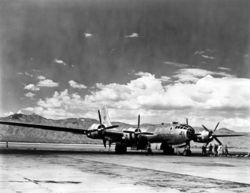
- ↑ Knaack, Marcelle Size (1988). Post-World War II bombers, 1945-1973. Office of Air Force History. ISBN 0-16-002260-6.
- ↑ Futrell 1976
- ↑ A76 Boeing Washington RAAF Museum. Accessed on 18 June 2006.
- ↑ Loftin, LK, Jr.. Quest for performance: The evolution of modern aircraft. NASA SP-468. Retrieved on 2006-04-22.
- Bowers, Peter M. (1999). Boeing B-29 Superfortress. Stillwater, Minnesota: Voyageur Press. ISBN 0-933424-79-5.
- Futrell RF, Greenhalgh WH, Grubb C, Hasselwander GE, Jakob RF, and Ravenstein CA (1976). The United States Air Force in Southeast Asia - Aces and aerial victories, 1965-1973. ISBN 0-8987-5884-X.
- Hess, William N. (1998). Big Bombers of WW II.
- Higham, Robin; Williams, Carol (editors) (1975). Flying combat aircraft of USAAF-USAF (Volume 1). Air Force Historical Foundation.. ISBN 0-8138-0325-X.
- LeMay, Curtis; Yenne, Bill (1988). Super Fortress. Berkley Books. ISBN 0-425-11880-0.
- Mann, Robert A. (2004). The B-29 Superfortress: A Comprehensive Registry of the Planes and Their Missions. Jefferson, North Carolina: McFarland & Company. ISBN 0-7864-1787-0.
- Pace, Steve (2003). Boeing B-29 Superfortress. Ramsbury, Marlborough, Wiltshire, United Kingdom: Crowood Press. ISBN 1-86126-581-6.
- Vander Meulen, Jacob (1995). Building the B-29. Washington, D.C.: Smithsonian Books. ISBN 1-56098-609-3). (The economic aspect of the B-29 program)
- Wheeler, Keith (1982). Bombers over Japan. Virginia Beach, Virginia: Time-Life Books. ISBN 0-8094-3429-6.
- Johnson, Robert E. "Why the Boeing B-29 Bomber, and Why the Wright R-3350 Engine?" American Aviation Historical Society Journal 1988 33(3): 174-189. ISSN 0002-7553
- "Boeing B-29 Superfortress." Encyclopedia of American Aircraft. Accessed on October 26, 2004.
- "Boeing B-29 "Superfortress". USAF Museum. Accessed on October 10, 2004.
- Deakin, John (2002-06-24). "Superfortress!". Pelican's Perch (56). Retrieved on 2006-01-15.
External links
- B-29.org, history and first-hand accounts
- B-29 Restoration Gallery, the restoration of Doc
- B-29 "DOC" Restoration Project, the restoration of Doc
- National Air and Space Museum, Smithsonian page on Enola Gay
- Preserved Aircraft, status of preserved B-29's
- Russian B-29 Clone, the reverse-engineered Tu-4
- Bombers Over Japan, development, photos, and history
- Warbirds Resource Group, specifications and photos
- 'Birth of the B29', film with anti-Japanese propaganda; footage of B-29 construction and testing begins at 4:00
- Pelican's Perch #56:Superfortress!, Article wrote by John Deakin, one of the pilots who regularly fly the world's only remaining flyable B-29
- WarbirdsRegistry.org B-29/B-50, Listing of surviving B-29's
- New England Air Museum's B-29 "Jack's Hack"
- Annotated bibliography on the B-29 from the Alsos Digital Library
Related content
Related development
- XB-39 Superfortress
- XB-44 Superfortress
- B-50 Superfortress
- C-97 Stratofreighter
- Boeing 377
- Tupolev Tu-4
Comparable aircraft
Designation sequence
| 345 (B-29) | - 367 - 377 - 400 | |
| 345 (B-39) | ||
| 345 (B-44) | ||
| 345 (B-50) |
Related lists
See also
- Island hopping
- Kee Bird - Crashed B-29 destroyed during an attempt at salvage
- AN/APQ-13 - radar used in later models
Lists relating to aviation | |
|---|---|
| General | Timeline of aviation · Aircraft · Aircraft manufacturers · Aircraft engines · Aircraft engine manufacturers · Airports · Airlines |
| Military | Air forces · Aircraft weapons · Missiles · Unmanned aerial vehicles (UAVs) · Experimental aircraft |
| Notable incidents and accidents | Military aviation · Airliners · General aviation · Famous aviation-related deaths |
| Records | Flight airspeed record · Flight distance record · Flight altitude record · Flight endurance record · Most produced aircraft |
cs:B-29 Superfortress da:B-29 Superfortress de:Boeing B-29 es:B-29 Superfortress fr:Boeing B-29 Superfortress gl:B-29 Superfortress it:Boeing B-29 Superfortress he:B-29 nl:B-29 Superfortress ja:B-29 (爆撃機) no:Boeing B-29 Superfortress pl:Boeing B-29 Superfortress pt:Boeing B-29 Superfortress sl:Boeing B-29 fi:B-29 Superfortress sv:Boeing B-29 Superfortress zh:B-29超級堡壘轟炸機
